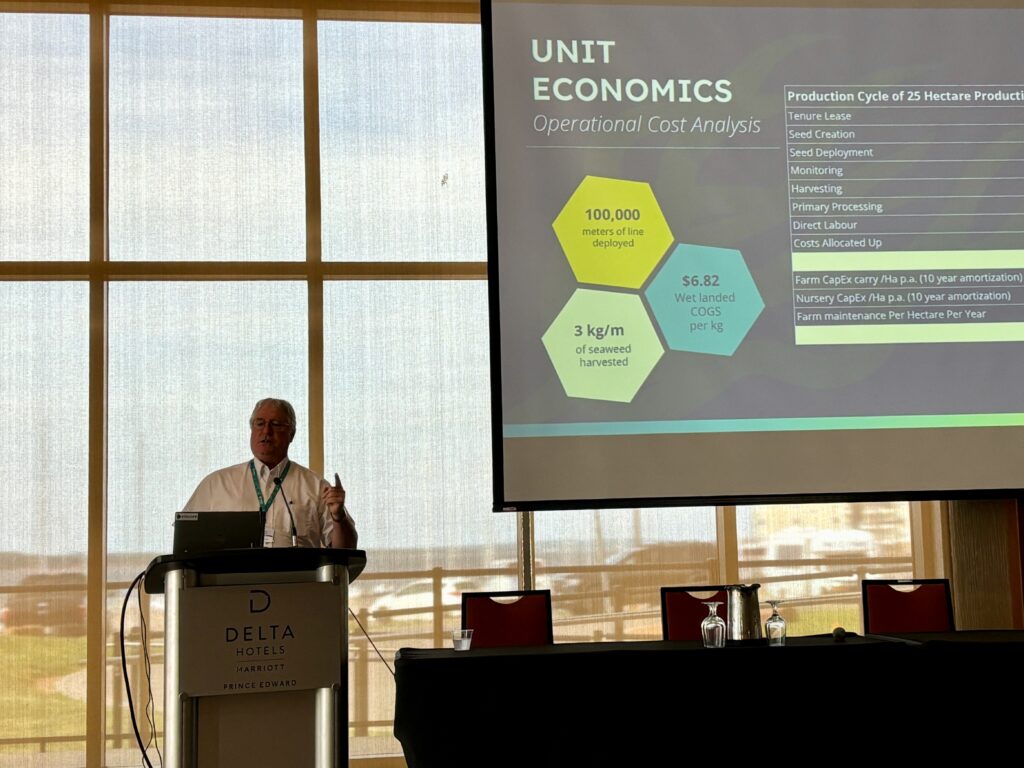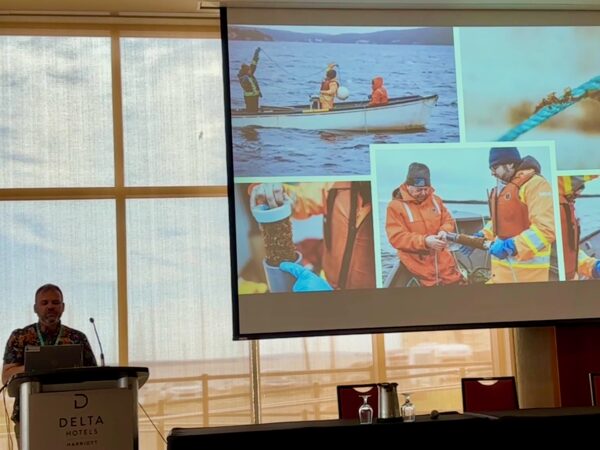
Aquaculture Canada 2024: economic challenges of seaweed farming in Canadian coasts
June 19, 2024
By
Seyitan Moritiwon
 William Collins, co-founder of British Colombia’s Cascadia Seaweed. (Photo: Seyitan Moritiwon, Aquaculture North America)
William Collins, co-founder of British Colombia’s Cascadia Seaweed. (Photo: Seyitan Moritiwon, Aquaculture North America) “There’s way more to aquaculture than finfish farming,” said William Collins, co-founder of British Colombia’s Cascadia Seaweed.
Collins gave a presentation at the June 16-19 Aquaculture Canada Conference and Trade Show, on the economics of seaweed farming in North America.
He stated that the operational cost analysis for his business cost C$1,289,500 (about US$940,000) with the bulk of the money going towards direct labour and costs. Harvesting costs about C$170,000 (about US$124,000) for one cycle. They started with harvesting three tons a day but when they transformed from using big fish totes to construction bags, production increased to 18 tons a day in 2023. Seed creation for the company’s 25 hectares in one year’s production cycle, costs about C$170,000.
Collins said the claims of seaweed being a big cash generator are not true. “Don’t believe it when somebody says you should grow seaweed, you’re going to make a fortune. It’s good for the planet. It’s good for coastal communities. I hope we’ll make a fortune, but that’s going to take some time and a lot of investment and a lot of risk-taking,” Collins said.
Cascadia Seaweed, founded in 2019, has been operating seven farms in Canadian six territories owned by First Nations tribes. He said seaweed in North America, particularly on the West Coast, is culturally and historically significant. Collins said he has tried to advocate for including seaweed in every shellfish license, with no further application and no six-month delay in British Columbia. It hasn’t proven easy.
He advised potential seaweed farmers to “pay attention to social license, stay on top of it. Work in your communities, and you’ll have an easier road. It’s not going to be a road that’s has no potholes in it, but it should be easier.”
On the same day, one of the newer seaweed farmers gave a presentation on artificial intelligence (AI) and seaweed developments in Newfoundland and Labrador.
In 2019, Michael Teasdale went to one of the Fridays for Future Climate Change protests with his daughter and realized he wanted to do something that can contribute to the world based on his values and skillsets as an environmental consultant. Three years later, he founded HoldfastNL Seaweed Farm, a seaweed growing industry in Newfoundland.

Michael Teasdale, owner of HoldfastNL Seaweed Farm. (Photo: Seyitan Moritiwon, Aquaculture North America)
Teasdale said the company has ongoing projects to foster seaweed production in the province. They’ve partnered with Coastal Carbon, a company that uses AI to deliver underwater data to seaweed farmers using satellite data and the College of the North Atlantic is going to run their Light Detection and Ranging (LIDAR) over the company’s seaweed site.
He also said Coastal Carbon is developing a pressure sensor to measure the pressure of the seaweed on the line. “We’re going to do the ground-truthing and measure the biomass and assess the site, and then they’re going to take all that information and put it in this AI black box and somehow spit out the numbers,” he said.
He said Newfoundland has of problem of not having have wastewater facilities, so his company partnered with Conception Bay South, a town in the province, to put a seaweed curtain out in front of their wastewater pipe. They’ll monitor the dispersion, and measure the water quality at the end of the pipe and in their facility. Finally, they’ll collect the seaweed and see what it looks like.
His company is also in discussions with researchers at Memorial University and Dalhousie to look at the nitrogen cycle and see how much nitrogen seaweed takes up. At the end of the project, the company will work with the local gardening community to test the seaweed and then donate it to the local garden club.
Advertisement
- Canada’s Ocean Supercluster project to measure kelp’s environmental impact”
- DFO minister expected to announce 5-year plan for B.C. salmon farming





